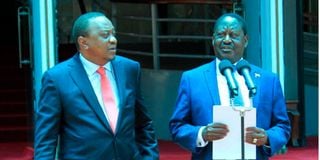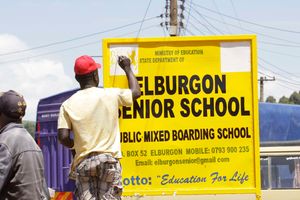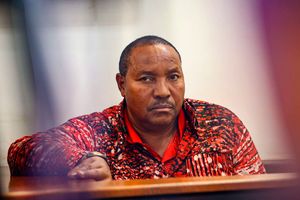Premium
How ‘Handshake’ devolved from an act of statesmanlike chivalry to a succession plot

President Uhuru Kenyatta and ODM party leader Raila Odinga at Harambee House in Nairobi on March 9, 2018, where they agreed to work together in a handshake. The duo will be in for the AfriCities Summit which starts tomorrow.
What you need to know:
- For Raila, conceding defeat to a rival he considered absolutely inferior was revolting.
- The Handshake was an opportunity to recalibrate this conflict, and consider terms of future engagement.
The Uhuru succession agenda entails several levels of diverse moving parts. Nevertheless, it is possible to generate a picture of the objectives, progress and prospects of the scheme by examining the behaviour patterns of the components of this machine.
In the past week, we struck a rich vein of evidence all but proving the case beyond reasonable doubt.
As originally advertised, the March 2018 Handshake between President Uhuru Kenyatta and then opposition chief Raila Odinga had nothing to do with 2022.
There is reason to believe that Uhuru was committed to this position, while Raila was focused on using the détente to assemble a compelling bid for the forthcoming polls.
This is the locus of the fundamental conflict underlying the entreprise.
This conflict was buttressed by a hearty mutual contempt between the two politicians, often cascading to hordes of their unwitting followers.
For Raila, conceding defeat to a rival he considered absolutely inferior was revolting. Claims of stolen election victory were not mere face-saving responses, they were consistent with his evaluation of his adversary as unworthy.
In 2002, Uhuru’s candidature outraged Raila to the point of summarily terminating his painstakingly crafted pact with Nyayo, bolting to Narc barely in the nick of time.
Uhuru’s presidency from 2013 therefore plunged Raila into prolonged distemper, and when vindication was not forthcoming in 2017, he went for broke.
Obviously, Uhuru, stung by his rival’s animus and contempt, gave as much as he got. He amplified murmured and whispered insinuations of Raila’s sinister proclivities, mocked his foibles and sneered at his affectations.
Creative permutations
Leveraging riots, violence, looting sprees and other disruptive side-effects of Raila’s ‘mass action’, Uhuru portrayed him as inimical to the economy and an existential threat to Kenya.
The Handshake was an opportunity to recalibrate this conflict, and consider terms of future engagement.
Raila saw an opportunity to access state machinery, the invisible variable he claimed had cost him victory in past contests. Kenyatta wanted relief from Raila’s war of attrition and also desired to avenge himself by neutralising Raila politically and retiring him from the scene.
Over the course of time, Uhuru deemed it fit to conduct his succession. However, this was complicated by the absence of a candidate with ability to mount a credible presidential campaign, given that Uhuru’s sidekicks had maintained that both William Ruto and Raila must retire with the President.
In that case, available options, for one reason or another, were not considered viable, even after creative permutations and combinations were frantically considered, and the BBI mooted to facilitate and legitimise astonishing political contrivances.
With Ruto resolute that his dreams are valid, the Handshake brigade had to bite the bullet and embrace Raila’s candidature. Raila’s expeditious rehabilitation in Jubilee strongholds and Uhuru’s mobilisation as Raila’s campaigner became imperative.
This confounding iteration of the Handshake revealed subsisting contradictions.
ODM damu arch-loyalists gloated about having the ‘Deep State’ on their side this time around, by dint of the Handshake placing ‘state machinery’ on Raila’s lap.
Aside from the inevitability this messaging signalled, it also plugged into ODM’s original claim; that Raila never lost (/fairly), and that Uhuru’s victories and legitimacy remain implicitly contested. For their part, Jubilee diehards confessed, repented and offered to atone for their sins by accompanying Raila to ‘climb the mountain’.
Fair enough!
The real succession
However, a caveat was embedded in this admirable offer: so effective had been their demonisation onslaught that selling Raila in Mt Kenya was ‘like hawking pigs in Mecca’, while ODM was repugnant and the colour orange anathema.
Hence, ODM gave way to Azimio, whose obverse is Jubilee, as orange gave way to purple.
Under the fraudulent pretext of engaging Mt Kenya, Raila would be prevailed upon to accept a running mate chosen for him and undertake to transmit power to him without delay.
Accordingly, references to a ‘Mandela term’, whereby his deputy would shortly succeed him, creating a vacancy for a further deputy, gained furious traction.
By this light, Raila was merely the opening act to the real succession.
In this game of suggestion, each side of the Handshake-Azimio consociation maintains its prejudices and grievances as articles of faith, yet simultaneously leverages them to devastating effect in a deadlocked game of sheer political toxicity.
The Sabina Chege controversy underscores the farcical contradictions of the Azimio conundrum: in lieu of selling Raila in Mt Kenya, Jubilee offers to conjure votes for him, via a ‘back room’.
Ironically, the leading lights of ODM’s electoral justice agenda are defending her before the IEBC’s Electoral Code of Conduct Enforcement Committee.
Thus did the Handshake – that memorable spectacle of statesmanlike chivalry – devolve into an unseemly pedestrian succession intervention bristling with passive-aggressive political energies.
The writer is an advocate of the High Court and a former State House speech writer. @EricNgeno





